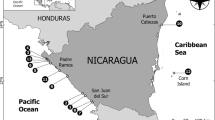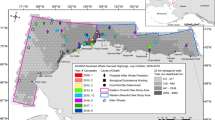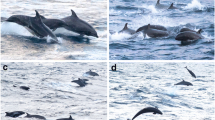Abstract
Nonaggressive mixed species groups of false killer whales (Pseudorca crassidens) and common bottlenose dolphins (Tursiops truncatus) are frequently observed at many locations around the world, but they are not commonly seen in Tierra del Fuego. This work reports the first sighting of a mixed pod of false killer whales and common bottlenose dolphins and its live mass-stranding event in the inner Beagle Channel, Tierra del Fuego (Argentina) in February 2022. The mixed pod was confirmed to be composed of ~ 50 false killer whales (including calves) and four common bottlenose dolphins, but only false killer whales were involved in the mass-stranding event which occurred at the inner and western sector of Ushuaia Bay next to urban settings. The interaction of natural and human-related factors appears to have caused the mass-stranding in this case; however, the reasons why the pod was inside the channel are still unknown. Although all animals were rescued alive, two animals were found dead days after the event. These sightings and stranding may be considered extralimital records for Tursiops truncatus and add new records in their southernmost (summer) range for Pseudorca crassidens. The handling of the situation during these events also suggest that a better marine mammal-stranding network response program is needed in this southern region.




Similar content being viewed by others
References
Aguayo A, Bernal R, Olavarría C, Vallejos V, Hucke-Gaete R (1998) Observaciones de cetáceos realizadas entre Valparaíso e Isla de Pascua, Chile, durante los inviernos de 1993, 1994 y 1995. Rev Biol Mar Oceanogr 33(1):101–123
Alvarado-Rybak M, Toro F, Escobar-Dodero J, Kinsley AC, Sepúlveda MA, Capella J et al (2020) 50 years of cetacean strandings reveal a concerning rise in Chilean Patagonia. Sci Rep 10(1):1–10
Andrade AL, Pinedo MC, Barreto AS (2001) Gastrointestinal parasites and prey items from a mass stranding of false killer whales, Pseudorca crassidens, in Rio Grande do Sul, southern Brazil. Revista Brasil Biol 61:55–61
Baird RW (2009) False killer whale Pseudorca crassidens. In: Perrin WF, Würsig B, Thewissen JGM (eds) Encyclopedia of Marine Mammals. Academic Press, Amsterdam, pp 405–406
Baird RW (2018) False killer whale: Pseudorca crassidens. In: Würsig B, Thewissen JGM, Kovacs KM (eds) Encyclopedia of marine mammals, 3rd edn. Academic Press, San Diego, CA, pp 347–349
Balcomb KC III, Claridge DE (2001) A mass stranding of cetaceans caused by naval sonar in the Bahamas. Bahamas J Sci 8(2):2–12
Balestrini C, Manzella G, Lovrich GA (1998) Simulación de corrientes en el Canal Beagle y BahíaUshuaia, mediante un modelo bidimensional. Serv Hidr Naval Dep Oceanog Infme Técn 98:1–58
Becker YA, Fioramonti NE, Dellabianca NA, Riccialdelli L (2021) Feeding ecology of the long-finned pilot whale, Globicephala melas edwardii, in the southwestern Atlantic Ocean, determined by stable isotopes analysis. Polar Biol 44(8):1655–1667
Best PB, Reeb D (2010) A near mass stranding of cetaceans in St. Helena Bay. South Africa Afr J Mar Sci 32:163–166
Borsa P (2006) Marine mammal strandings in the New Caledonia region. Southwest Pacific c r Biol 329(4):277–288
Brabyn M, McLean IG (1992) Oceanography and coastal topography of herd-stranding sites for whales in New Zealand. J Mammal 73:469–476
Bradshaw CJA, Evans K, Hindell MA (2006) Mass cetacean strandings: a plea for empiricism. Conserv Biol 20:584–586. https://doi.org/10.1111/j.1523-1739.2006.00329.x
Brun AA, Ramirez N, Pizarro O, Piola AR (2020) The role of the Magellan Strait on the southwest South Atlantic shelf. Estuar Coast Shelf Sci 237:106661
Bustos RL, Negri MF, Daneri GA, Varela EA, Luna M (2015) Finding of a skull of Pseudorca crassidens in Caleta de Los Loros, Rio Negro Province. Argent Lat Am J Aquat Mamm 10:65–67
Cáceres-Saez I, Haro D, Blank O, Aguayo-Lobo A, Dougnac C, Arredondo C et al (2019) Stranded false killer whales, Pseudorca crassidens, in Southern South America reveal potentially dangerous silver concentrations. Mar Pollut Bull 145:325–333
Cordes DO (1982) The causes of whale strandings. N Zeal Vet J 30:21–24
Crofts S, Martien K, Robertson KM, Stanworth A, Massam S, Weir CM (2019) First record of false killer whales (Pseudorca crassidens) in the Falkland Islands (Malvinas). Polar Biol 42:1923–1929. https://doi.org/10.1186/s41200-018-0153-2
Cucco A, Martín J, Quattrocchi G, Fenco H, Umgiesser G, Fernández DA (2022) Water circulation and transport time scales in the Beagle Channel, southernmost tip of South America. J Mar Sci Eng 10(7):941
Evans K, Thresher R, Warneke RM, Bradshaw CJ, Pook M, Thiele D, Hindell MA (2005) Periodic variability in cetacean strandings: links to large-scale climate events. Biol Lett 1(2):147–150
Flores MA, Moraga R, Pérez MJ, Hanshing E, Olavarría C (2003) New sightings of false killer whale Pseudorca crassidens (Owen 1846) in Chile. Rev Biol Mar Oceanog 38(2):81–85
Fuentes HR (1987) Observaciones sobre Pseudorca crassidens (Owen 1846) (Odontoceti: Delphinidae) varadas en Los Choros, Coquimbo, IV Región, Chile. Anales Del Museo De Historia Natural De Valparaíso 18:169–175
Giesecke Astorga CR, Martín de Nascimento J, Piñones A, Höfer J, Garcés Vargas J, Flores Melo EX et al (2021) General hydrography of the Beagle Channel, a subantarctic interoceanic passage at the southern tip of South America. Front Mar Sci. https://doi.org/10.3389/fmars.2021.621822
Goodall RNP (1978) Report on the small cetaceans stranded on the coasts of Tierra del Fuego. ICR 30:197–230
Goodall RNP, Boy CC, Schiavini ACM (2007) Historical and modern records of cetacean self-stranding to escape from killer whale. In: Paper SC/59/SM17presented to the scientific committee, 2007. IWC 19 pp. Available from. www.iwcoffice.org.
Goodall RNP, Benegas LG, Boy CC, Dellabianca N, Pimper L, Riccialdelli L (2008) Review of small cetaceans stranded or incidentally captured on the coast of Tierra del Fuego, Argentina, over 33 years. In: Paper SC/60/SM21 presented to the scientific committee, June 2008. IWC. 14. pp. Available from. www.iwcoffice.org.
Goodall RNP, Marchesi MC, Pimper LE et al (2011) Southernmost records of bottlenose dolphins. Tursiops Truncatus Polar Biol 34:1085–1090. https://doi.org/10.1007/s00300-010-0954-1
Gordon J, Gillespie D, Potter J, Frantzis A, Simmonds MP, Swift R, Thompson D (2003) A review of the effects of seismic surveys on marine mammals. Mar Technol Soc J 37:16–34
Hall MA, Alverson DL, Metuzals KI (2000) By-catch: problems and solutions. Mar Pollut Bull 41(1–6):204–219
Halpin LR, Towers JR, Ford JK (2018) First record of common bottlenose dolphin (Tursiops truncatus) in Canadian Pacific waters. Mar Biodiver Rec 11(1):1–5
Haro D, Aguayo-Lobo A, Blank O, Cifuentes C, Dougnac C, Arredondo C, Cáceres-Saez I et al (2015) Nuevo varamiento masivo de orca falsa, Pseudorca crassidens, en el Estrecho de Magallanes, Chile. New massive stranding of false killer whale, Pseudorca crassidens, in the Strait of Magellan. Chile Rev Biol Mar Oceanog 50:149–155. https://doi.org/10.4067/S0718-19572015000100013
Kasuya T (1971) Consideration of distribution and migration of toothed whales off the Pacific coast of Japan based upon aerial sighting record. Sci Rep Whales Res Inst 23:37–60
Koen Alonso M, Pedraza SN, Schiavini ACM, Goodall RNP, Crespo EA (1999) Stomach contents of false killer whales (Pseudorca crassidens) stranded along the Strait of Magellan. Mar Mammal Sci 15:712–724
Langguth A (1977) Notas sobre la falsa orca “Pseudorca crassidens” (Owen) en el Atlantico Suboccidental. Rev Inst Invest Cien Nat 12(6):59–68
Leatherwood S, McDonald D, Baird RW and Scott MD (1989) The false killer whale, Pseudorca crassidens (Owen, 1846): a summary of information available through 1988. Oceans Unlimited Technical Report, San Diego, p. 114.
López A, Santos MB, Pierce GJ, González AF, Valeiras X, Guerra A (2002) Trends in strandings and by-catch of marine mammals in north-west Spain during the 1990s. J Mar Biolog Assoc 82(3):513–521
Mansilla L, Olavarría C, Vega MA (2012) Stomach contents of long-finned pilot whales (Globicephala melas) from southern Chile. Polar Biol 35:1929–1933
Moore KM, Simeone CA, Brownell RL Jr (2018) Strandings. Encyclopedia of marine mammals. Academic Press, Cambridge, pp 945–951
Nowacek DP, Thorne LH, Johnston DW, Tyack PL (2007) Responses of cetaceans to anthropogenic noise. Mammal Rev 37(2):81–115
Oliveira Alves MD, Oliveira AC, de Meirelles D, de Rệgo-Barros, Negrāo-Silva CP, Alves-Campos A (2002) Primeiro registro de falsa orca, Psedorca crassidens (Cetacea: Delphinidae), Para o litoral do estado do Ceara. Arq Cien Mar 35:107–112
Oporto JA, Lescrauwaet AC, Maslow N, Matus R, Canto J, Turina O. 1994. Primeros antecedentes ambientales de un varamiento masivo de falsa orca (Pseudorca crassidens), ocurrido en el estrecho de Magallanes, Chile. In: Oporto, J.A. (Ed.), Anales de la IV Reunión de Trabajo de Especialistas en Mamíferos Acuáticos de América del Sur. Centro de Investigación y Manejo de Mamíferos Marinos, Valdivia, pp. 277–285.
Palmer C, Fitzgerald C, Wood A, Harley S, McKenzie A (2009) False killer whales Pseudorca crassidens: regular visitors to Port Essington and Darwin Harbour in the Northern Territory, Australia. North Territ Nat 21:49–53
Ryan C, Cohen M, Baird RW (2020) Southernmost record of false killer whale (Pseudorca crassidens). Aquat Mamm 6:111–113. https://doi.org/10.1578/AM.46.1.2020.111Letter
Stacey PJ, Baird RW (1991) Status of the false killer whale, Pseudorca crassidens. Canada Can Field-Nat 105:189–197b
Van Waerebeek K, Baker AN, Felix F, Gedamke J, Iñiguez M, Sanino GP et al (2007) Vessel collision with small cetaceans worldwide and with large whales in the Southern Hemisphere, an initial assessment. LAJAM 6:43–69
Vanselow KH, Jacobsen S, Hall C, Garthe S (2018) Solar storms may trigger sperm whale strandings: explanation approaches for multiple strandings in the North Sea in 2016. Int J Astrobiol 17(4):336–344
Weilgart LS (2007) The impacts of anthropogenic ocean noise on cetaceans and implications for management. Can J Zool 85(11):1091–1116
Zaeschmar JR. 2014b. False killer whales (Pseudorca crassidens) in New Zealand waters: a thesis presented in partial fulfilment of the requirements for the degree of Master of Science in Conservation Biology at Massey University, Albany, New Zealand (Doctoral dissertation, Massey University).
Zaeschmar JR, Dwyer SL, Stockin KA (2013) Rare observations of false killer whales (Pseudorca crassidens) cooperatively feeding with common bottlenose dolphins (Tursiops truncatus) in the Hauraki Gulf. N. Z. Mar Mamm Sci 29(3):555–562
Zaeschmar JR, Visser IN, Fertl D, Dwyer SL, Meissner AM, Halliday J, Berghan J, Donnelly D, Stockin KA (2014) Ocurrence of false killer whales (Pseudorca crassidens) and their association with common bottlenose dolphins (Tursiops truncatus) off northeastern New Zealand. Mar Mamm Sci 30:594–608
Zylber MI, Failla G, Le Bas A (2002) Stenurus globicephalae Baylis et Daubney, 1925 (Nematoda: Pseudaliidae) from a false killer whale, Pseudorca crassidens (Cetacea: Delphinidae), stranded on the coast of Uruguay. Mem Inst Oswaldo Cruz 97:221–225
Acknowledgements
We are indebted to all the people that tried to help during the stranding event and in particular to Prefectura Naval Argentina (PNA) and Secretaría de Ambiente de Tierra del Fuego to activate the marine mammal-stranding response program as soon as possible. We are grateful to all divers from the PNA, the Centro Austral de Investigaciones Científicas (CADIC), the Universidad Nacional de Tierra del Fuego, and the “Let’s Dive” diving operator for performing the rescue of several trapped false killer whale individuals. We also thank A Ferlito, pilot of the CADIC boat, for his assistance during boat surveys and CADIC-CONICET for logistic support. We especially thank AG. Rodriguez, T. Ditmar, and Dra. Harris who helped revise the English text.
Funding
This study was funded by CONICET (PUE 2016, PIP-2023), the Wildlife Conservation Society (WCS, Sofar Trident OpenROV), and the AMP Namuncurá-Burdwood Bank Administration (hydrophone). ASM was funded by postdoctoral fellowships from CONICET.
Author information
Authors and Affiliations
Contributions
ASM, MNPV, ND, and LR designed the study and wrote the original manuscript. All authors contributed to fieldwork: CO made the acoustic recording with a hydrophone; BT and LR made the film recording with Sofar Trident OpenROV; MT and ASM made the film recording with GoPro; and AD, ND, and NA made sightings and took photographs. All authors read, revised, and approved the manuscript. ND and LR obtained funding for this study.
Corresponding author
Ethics declarations
Conflict of interest
The authors declare that they have no conflict of interest.
Ethical approval
The study was performed under Provincial permit Res.SA Nº 0279/2021 granted by Ministerio de Producción y Ambiente, Secretaría de Ambiente, Ushuaia, Tierra del Fuego.
Additional information
Publisher's Note
Springer Nature remains neutral with regard to jurisdictional claims in published maps and institutional affiliations.
Supplementary Information
Below is the link to the electronic supplementary material.
Supplementary file1 (MP4 2395 KB)
Supplementary file2 (MP4 8984 KB)
Supplementary file3 (MP4 58365 KB)
Supplementary file4 (MP4 57016 KB)
Rights and permissions
Springer Nature or its licensor (e.g. a society or other partner) holds exclusive rights to this article under a publishing agreement with the author(s) or other rightsholder(s); author self-archiving of the accepted manuscript version of this article is solely governed by the terms of such publishing agreement and applicable law.
About this article
Cite this article
San Martín, A.A., Paso Viola, M.N., Tartaglia Gamarra, M.B. et al. Unusual occurrence of a mixed pod of false killer whales (Pseudorca crassidens) and common bottlenose dolphins (Tursiops truncatus) in the Beagle Channel (Argentina). Polar Biol 46, 589–595 (2023). https://doi.org/10.1007/s00300-023-03145-5
Received:
Revised:
Accepted:
Published:
Issue Date:
DOI: https://doi.org/10.1007/s00300-023-03145-5




